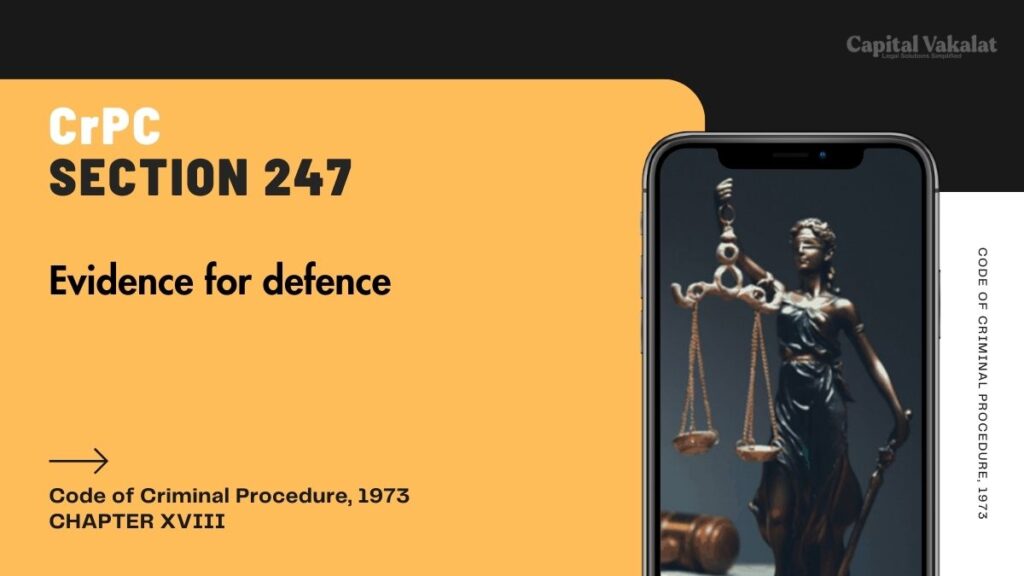The Criminal Procedure Code (CrPC) forms the backbone of criminal law in India, delineating the procedures for conducting trials, inquiries, and investigations. One of the pivotal sections within this code is Section 247, which outlines the provisions for presenting evidence in defense during a criminal trial.

This article delves into the intricacies of Section 247 CrPC, its implications for the defense, and how it shapes the course of criminal justice in India.
Bare Act. Section 247 Cr.P.C.
Evidence for defence.
The accused shall then be called upon to enter upon his defence and produce his evidence; and the provisions of section 243 shall apply to the case.
The Role of Evidence in Criminal Trials
Evidence serves as the cornerstone of any legal proceeding, particularly in criminal trials where the stakes are incredibly high. The burden of proof lies with the prosecution, but the defense has an equally critical role in challenging the evidence presented and providing their own evidence to counter the charges. Understanding the dynamics of evidence is essential for comprehending the significance of Section 247 CrPC.
Section 247 CrPC: An Overview
Historical Context
Section 247 CrPC has evolved through various legal reforms and amendments. Its roots can be traced back to the British colonial era, where the need for a comprehensive legal framework led to the codification of criminal procedures. Over the years, it has been refined to meet the changing demands of justice and fairness in the legal system.
Key Provisions
The core of Section 247 lies in its provision that allows the accused to present evidence in their defense after the prosecution has closed its case. This is a crucial phase in the trial, as it provides the defendant with an opportunity to counter the prosecution’s allegations and present their version of events.
Legal Framework of Section 247 CrPC
Step-by-Step Process
- Closure of Prosecution Evidence: The trial court marks the end of the prosecution’s evidence, signaling the start of the defense phase.
- Accused’s Statement: The court examines the accused under Section 313 CrPC to understand their defense.
- Submission of Defence Evidence: The accused, through their legal counsel, presents evidence, which can include witness testimonies, documents, and expert opinions.
- Cross-examination: The prosecution has the right to cross-examine the defense witnesses.
- Final Arguments: Both parties present their final arguments, after which the court delivers its judgment.
Rights of the Accused under Section 247 CrPC
Fundamental Rights
Section 247 CrPC embodies the principles of natural justice, ensuring that the accused is given a fair opportunity to defend themselves. This aligns with the fundamental rights guaranteed under the Indian Constitution, particularly Article 21, which assures the right to life and personal liberty.
Collection of Evidence for Defence
Strategies and Techniques
Gathering evidence for defense requires meticulous planning and a strategic approach. Defense lawyers must:
- Conduct thorough investigations.
- Identify and interview potential witnesses.
- Gather documentary and physical evidence.
- Consult with experts to provide technical or scientific insights.
Admissibility of Defence Evidence
Legal Standards
Not all evidence presented by the defense is admissible in court. The evidence must be relevant, reliable, and meet the legal standards of admissibility. Courts scrutinize the evidence to ensure that it adheres to the rules of evidence, safeguarding the trial’s integrity.
Challenges in Presenting Defence Evidence
Common Obstacles
Defense attorneys often face numerous challenges, including:
- Limited access to evidence held by the prosecution.
- Witness intimidation or reluctance to testify.
- Procedural hurdles and stringent evidentiary rules.
- Time constraints and limited resources.
Judicial Interpretation of Section 247 CrPC
Landmark Judgments
Several landmark judgments have shaped the interpretation and application of Section 247 CrPC. These rulings provide valuable insights into how courts view the rights of the accused and the admissibility of defense evidence. Understanding these precedents is crucial for effective legal practice.
Case Studies: Section 247 CrPC in Action
Real-life Examples
Analyzing real-life cases where Section 247 CrPC has played a pivotal role helps in understanding its practical implications. These case studies highlight the challenges faced by the defense and the strategies employed to overcome them.
Best Practices for Defence Lawyers
Effective Representation
For defense lawyers, representing a client effectively under Section 247 CrPC requires a deep understanding of the legal provisions, strategic planning, and robust evidence collection. Building a strong defense case involves:
- Comprehensive preparation.
- Effective cross-examination techniques.
- Skillful presentation of evidence.
Impact of Section 247 CrPC on Criminal Justice System
Broader Implications
Section 247 CrPC significantly impacts the criminal justice system by ensuring that the accused have a fair chance to defend themselves. This provision upholds the principles of justice and equality, contributing to the overall credibility and fairness of the legal system.
Comparative Analysis: Section 247 CrPC vs. Other Jurisdictions
International Perspectives
Comparing Section 247 CrPC with similar provisions in other jurisdictions provides a broader perspective on how different legal systems handle the defense’s right to present evidence. This comparative analysis can highlight best practices and areas for improvement.
Reforms and Recommendations
Enhancing Effectiveness
To further enhance the effectiveness of Section 247 CrPC, several reforms can be considered:
- Simplifying procedural requirements.
- Ensuring better access to evidence for the defense.
- Strengthening witness protection measures.
- Providing adequate resources for defense attorneys.
Future of Section 247 CrPC
Trends and Predictions
The future of Section 247 CrPC will likely see further refinements and adaptations to meet the evolving demands of justice. Emerging trends such as the use of digital evidence and technological advancements in legal practice will shape its application.
Conclusion
Section 247 CrPC plays a pivotal role in ensuring that the accused in criminal trials have a fair and just opportunity to present their defense. By understanding its provisions, challenges, and judicial interpretations, legal practitioners can better navigate the complexities of criminal trials. Continuous reforms and adaptations will further strengthen its application, ensuring justice is served effectively.